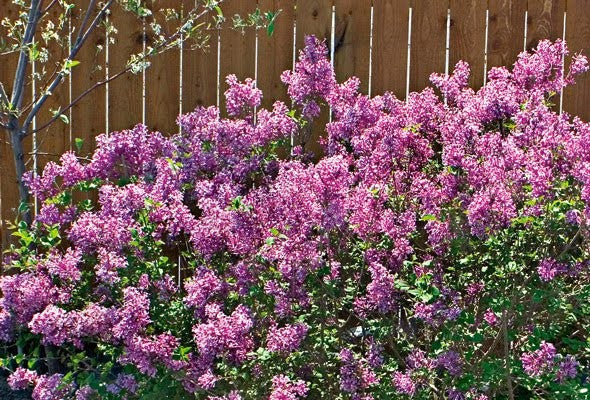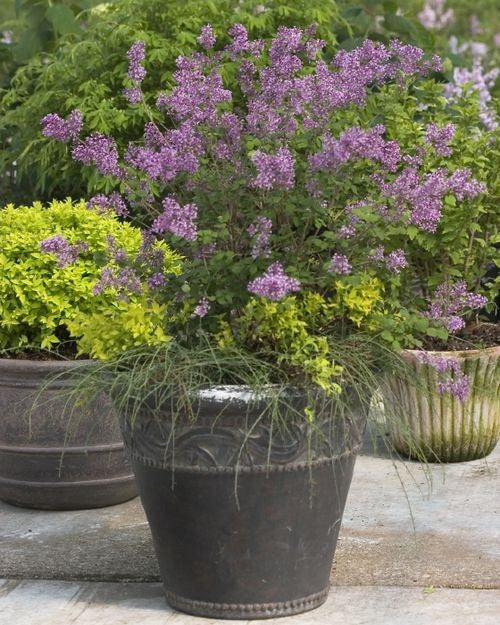by Ken Lain, the mountain gardener

Bloomerang Lilac is exactly as the name infers, a pulsating bloomer the comes back into bloom several times each year. The fragrance will remind you of visits to Grandmother’s house. A truly outstanding lilac for the large flowers and captivating fragrance, and super easy to grow. She is in a class by herself, even in the hottest of sun locations. In fact, the more sun she receives, the more flowers you will have.
Lilac lovers simply can’t get enough of this old-fashioned bloomer. Mountain lilacs bloom for about 3 weeks in April and May, and before you know it, it’s over. Gardeners who cannot get enough of the look and fragrance of lilac have the option to plant late-blooming varieties. Or, they can add a Bloomerang lilac into the gardens.
In May, around the same time as the common lilac, Bloomerang blooms heavily. In June, the shrub takes a break before blooming again until the first frost.
The spring bloom is different from the summer and fall bloom when the panicles are smaller and darker in color than in the spring.
The beautiful color and fragrance of this reblooming lilac are not just for gardeners; butterflies and hummingbirds love the bloom equally.
Botanical Name Syringa
Common Name Bloomerang lilac, reblooming lilac
Plant Type Deciduous shrub
Mature Size 4′ feet x 4′ feet
Sun Exposure 6+ hours full sun
Soil Type Well drained soil
Soil pH 6 to 8
Bloom Time Spring and mid-summer through fall
Flower Color Lavender, pink, purple
Hardiness Zones 3-8
How to Grow Bloomerang Lilac
Hybrids like Bloomerang lilac are bred for best performance and disease-resistance. They are a low-maintenance and almost carefree shrub for borders, foundations, and privacy screens. Bloomerang can be planted as a specimen, in small groups, or as mass plantings.
Soil
Like all lilacs, Bloomerang prefers soil that is rich in organic matter. The soil can be neutral to slightly alkaline. Good drainage is essential; lilacs do poorly in soggy, wet soil.
How to plant
1.Dig hole 2-3 times the width of the container but the same depth.
2. Score the root ball sides and bottom with a utility knife or pruners and place them in the planting hole.
3. Blend Watters Premium Mulch into the native soil at 1 part mulch with two parts soil dug from the hole and pack firmly around the roots.
4. Sprinkle 7-4-4 All Purpose Plant Food around the planting area.
5. Prevent ‘Transplant Shock’ by adding Watters “Root & Grow” to your water at 2-week cycles for the first 2 months.
6. Use the remaining Watters Mulch inside the tree well as a top dressing. This will keep weeds down, insulate roots from heat and cold, and keep the roots moist.
Light
Bloomerang lilac tolerates mountain wind, even on the highest ridgelines. She does best in at least 6 hours of sun; the more, the better. It can tolerate partial shade, but it comes at the cost of reduced bloom.
Water newly planted trees regularly with a garden hose for at least one month (2 months in Summer). Automatic irrigation systems may not be sufficient initially. Water frequency will vary according to season, exposure and plant size.
April – Oct Lilac should be irrigated 2 x weekly
Nov – Mar Lilac should be irrigated 2 x monthly
Feed 4x Times per Year with either 7-4-4 All Purpose Plant Food, Soil Sulfur, or Humic. Here’s the recommendation by season:
Spring = 7-4-4 All Purpose Food + Soil Sulfur
Summer = 7-4-4 All Purpose Food + Humic
September = 7-4-4 All Purpose Food
December = 7-4-4 All Purpose Food
Temperature and Humidity
Like most lilacs, Bloomerang needs an extended period of cold winter, making it perfect for cold mountain landscapes. In areas with hot (100+ degree) summers, lilac blooms longer in locations that provide some shelter from the strong afternoon sun. Summer monsoon rains encourage this shrub to rebloom.
The shrub is not affected by humidity unless the weather is sweltering and humid, which will slow down the reblooming.
Pruning
Bloomerang blooms on old and new wood and does not require pruning. You can remove the spent flowers after the spring bloom for a neater appearance, but it’s not essential.
Varieties of Bloomerang Lilac
- Bloomerang Purple is a standard-size cultivar with lavender-colored flowers.
- Bloomerang Dark Purple is a standard-size cultivar with dark purple flowers.
- Bloomerang Pink Perfume is another standard-size cultivar with pink flowers.
- Bloomerang Dwarf Pink is a compact dwarf cultivar that reaches only two to three feet in height and spread. It has pink flowers.
- Bloomerang Dwarf Purple is another compact dwarf cultivar with purple flowers.

Growing Bloomerang Lilac in Containers
Unlike common lilac and other large varieties, Bloomerang can easily be grown in containers. Keep in mind that lilacs, even compact varieties, have an extensive root system. The container should be large, at least 18+ inches in diameter.
Before you start, check out these common container gardening mistakes, such as filling the container in the wrong place. A large container can hold 15 gallons or more, and moving it after you plant can be cumbersome.
Sufficient watering is crucial to keep your Bloomerang lilac alive and blooming. Follow the instructions for watering container plants.
Common Pests/Diseases
All lilacs are deer and javelina resistant. Bloomerang lilac is more resistant to powdery mildew and leaf spots than common lilac. Because powdery mildew, a fungus, thrives in humid weather, ensure good air circulation in and around your Bloomerang lilac by giving it enough space.

